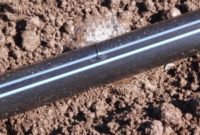
Drip irrigation technology has evolved into a popular way for landscapers to maximize the aesthetic beauty and quality of landscapes, while at the same time optimize resource use and reduce damage and risk from applying water to non-planted areas. In short, landscapers typically use drip irrigation where it doesn’t make sense to use traditional sprays or sprinklers, or to water by hand. The following are advantages to using drip in landscape applications:
- Water is confined to the targeted plant’s rootzone, so overspray onto sidewalks, buildings, cars and roadways is prevented.
- Flow rates and application rates are typically very low, so runoff from heavier soils, or steep slopes, may be avoided.
- Water is not applied into the air so wind drift or pattern distortion does not occur.
- Plants are not wetted which can result in the reduction of disease.
- Weed growth is reduced if non-targeted areas are not wetted.
- Water is applied at low pressures which may reduce pumping costs in some applications.
- Initial irrigation equipment investment costs can be reduced since flow rates are low, allowing the use of smaller and/or fewer valves and pipelines.
- Labor for installation may be reduced with the associated reduction in pipelines and surface placement of drip tubes.
